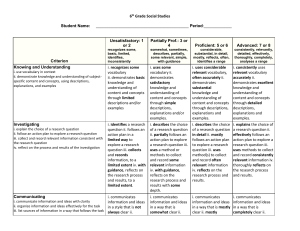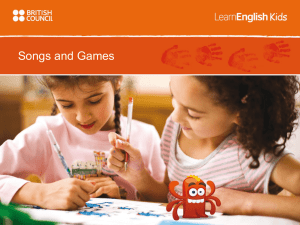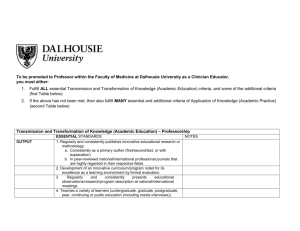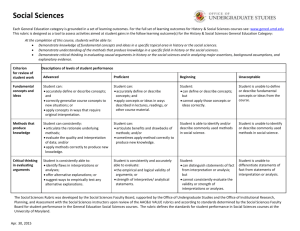Kindergarten Rubric for English Language Arts
advertisement
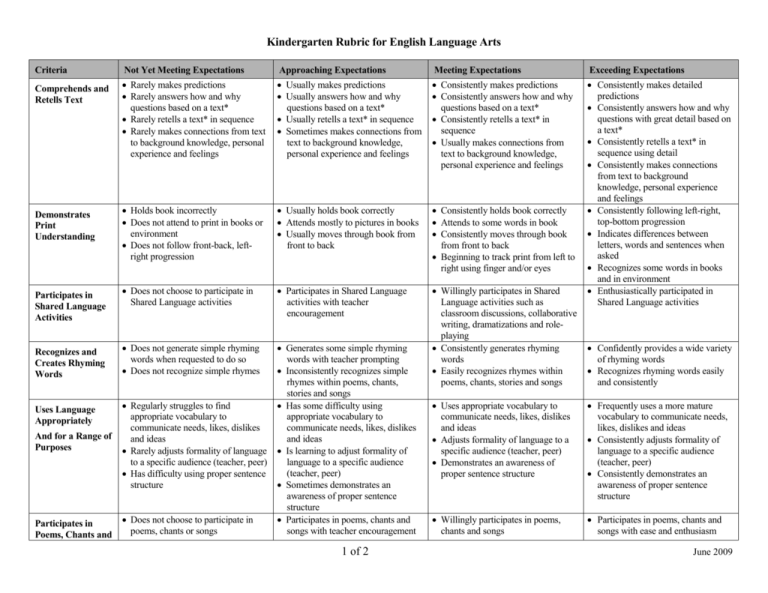
Kindergarten Rubric for English Language Arts Criteria Comprehends and Retells Text Demonstrates Print Understanding Participates in Shared Language Activities Recognizes and Creates Rhyming Words Uses Language Appropriately And for a Range of Purposes Participates in Poems, Chants and Not Yet Meeting Expectations Approaching Expectations Meeting Expectations Exceeding Expectations Rarely makes predictions Rarely answers how and why questions based on a text* Rarely retells a text* in sequence Rarely makes connections from text to background knowledge, personal experience and feelings Usually makes predictions Usually answers how and why questions based on a text* Usually retells a text* in sequence Sometimes makes connections from text to background knowledge, personal experience and feelings Consistently makes predictions Consistently answers how and why questions based on a text* Consistently retells a text* in sequence Usually makes connections from text to background knowledge, personal experience and feelings Holds book incorrectly Does not attend to print in books or environment Does not follow front-back, leftright progression Usually holds book correctly Attends mostly to pictures in books Usually moves through book from front to back Consistently holds book correctly Attends to some words in book Consistently moves through book from front to back Beginning to track print from left to right using finger and/or eyes Does not choose to participate in Shared Language activities Participates in Shared Language activities with teacher encouragement Does not generate simple rhyming words when requested to do so Does not recognize simple rhymes Generates some simple rhyming words with teacher prompting Inconsistently recognizes simple rhymes within poems, chants, stories and songs Has some difficulty using appropriate vocabulary to communicate needs, likes, dislikes and ideas Is learning to adjust formality of language to a specific audience (teacher, peer) Sometimes demonstrates an awareness of proper sentence structure Participates in poems, chants and songs with teacher encouragement Willingly participates in Shared Language activities such as classroom discussions, collaborative writing, dramatizations and roleplaying Consistently generates rhyming words Easily recognizes rhymes within poems, chants, stories and songs Consistently makes detailed predictions Consistently answers how and why questions with great detail based on a text* Consistently retells a text* in sequence using detail Consistently makes connections from text to background knowledge, personal experience and feelings Consistently following left-right, top-bottom progression Indicates differences between letters, words and sentences when asked Recognizes some words in books and in environment Enthusiastically participated in Shared Language activities Regularly struggles to find appropriate vocabulary to communicate needs, likes, dislikes and ideas Rarely adjusts formality of language to a specific audience (teacher, peer) Has difficulty using proper sentence structure Does not choose to participate in poems, chants or songs 1 of 2 Confidently provides a wide variety of rhyming words Recognizes rhyming words easily and consistently Uses appropriate vocabulary to communicate needs, likes, dislikes and ideas Adjusts formality of language to a specific audience (teacher, peer) Demonstrates an awareness of proper sentence structure Frequently uses a more mature vocabulary to communicate needs, likes, dislikes and ideas Consistently adjusts formality of language to a specific audience (teacher, peer) Consistently demonstrates an awareness of proper sentence structure Willingly participates in poems, chants and songs Participates in poems, chants and songs with ease and enthusiasm June 2009 Recognizes LowerCase Letters May inconsistently recognize some lower-case letters Recites/Sings some simple, wellpracticed chants or songs May be able to sing the alphabet May be able to state the alphabet with teacher prompting Recognizes fewer than 20 lowercase letters Recognizes UpperCase Letters May inconsistently recognize some upper-case letters Recognizes fewer than 20 uppercase letters Recognizes 20 or more upper-case letters Consistently recognizes all 26 upper-case letters Recognizes and produces less than 50% of consonant and vowel sounds Recognizes and produces less than 80% of consonant and vowel sounds Recognizes and produces 80% or more of consonant and vowel sounds Consistently recognizes and produces all consonant and vowel sounds Songs States Alphabet Recognizes Letter Sounds Does not recite/sing even simple chants or songs Can sing or state less than half the alphabet 2 of 2 Recites/sings chants and songs along with group Consistently states (not sings) the alphabet in correct order Recognizes 20 or more lower-case letters Independently recites/sings chants and songs Identifies the letter that comes before or after a given letter within the alphabet Consistently recognizes al 26 lower-case letters June 2009
